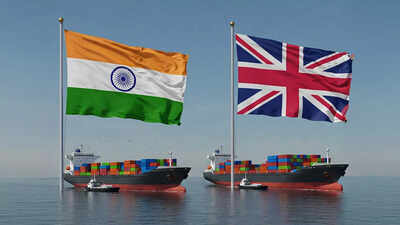India-UK trade deal: Prime Minister Narendra Modi announced on X (formerly Twitter), the ‘historic milestone’ that India and the UK have achieved in concluding a Free Trade Agreement (FTA) between the two countries. The agreement is anticipated to be officially signed when the British Prime Minister Keir Starmer visits India this year.The agreement eliminates tariffs on 99 per cent of Indian products entering the UK market, whilst facilitating the movement of Indian professionals to Britain for employment opportunities, without altering the UK’s existing points-based immigration framework.The United Kingdom and India, the world’s sixth and fifth-largest economies respectively, finalised their agreement following three years of intermittent discussions.The trade volume between India and the UK rose to $21.34 billion in 2023-24, compared to $20.36 billion in 2022-23. The goods exchange during April-January 2024-25 reached $21.33 billion, surpassing the previous period’s USD 20.26 billion. India maintains a favourable trade surplus in this relationship.Government officials have termed this agreement beneficial for both countries. It promises to provide Indian consumers with high-quality products at reasonable prices, stimulating domestic consumption and economic growth. Simultaneously, it offers British businesses access to India’s substantial and developing market, supporting the UK government’s economic expansion objectives, officials believe.
What Does India-UK FTA Mean For India?
- The Free Trade Agreement provides extensive market accessibility for products across sectors, encompassing all of India’s export priorities.
- With tariff elimination on approximately 99% of lines representing nearly 100% of trade value, India stands to benefit significantly, creating substantial prospects for enhanced trade relations between India and the UK.
- The agreement delivers favourable outcomes for manufacturing in both labour-intensive and technology-driven industries. It creates new export avenues for diverse sectors including textiles, marine products, leather, footwear, sports goods and toys, gems and jewellery.
- The agreement eliminates tariffs on exports of products requiring substantial workforce involvement, including leather items, shoes and garments. Indian exports such as apparel, frozen prawns, and precious stones and jewellery will see a reduction in tax rates.
- Additionally, it benefits crucial industries such as engineering goods, auto parts and engines, and organic chemicals. These provisions will notably strengthen the competitive position of Indian products in the UK market compared to other nations.
- The Free Trade Agreement will create substantial job opportunities across India, says the government.
- Notable benefits for British industries include a reduction in Scotch whisky duties from 150 per cent to 75 per cent, eventually decreasing to 40 per cent. This in turn would translate into cheaper Scotch whisky for Indians.
- The automotive duty rates will decrease from the current level of over 100 per cent to 10 per cent, with quota restrictions in place. UK-made cars, such as Jaguars and Land Rovers, will decrease from over 100% to 10% under a quota system, facilitating greater access to the Indian automotive market. This would mean cheaper cars from the UK.
- India has successfully negotiated the inclusion of additional professional categories, including chefs, musicians and yogis, within the UK’s visa pathways.
- India stands to gain from the UK’s Free Trade Agreement commitments across multiple service sectors, encompassing IT/ITeS, financial services, professional services and educational services.
- The trade pact features reduced import duties on diverse products, delivering advantages to Indian businesses and consumers alike. The items covered include cosmetics, aerospace parts, lamb, medical devices, salmon, electrical machinery, soft drinks, chocolate and biscuits.
- A wide range of Indian products will receive duty-free entry into the UK market, such as minerals, chemicals, gems and jewellery, plastic, rubber, wood, paper, textile, clothing, glass, ceramic, base metals, mechanical and electrical machinery, arms/ammunition, transport/auto, furniture, sports goods, animal products, and processed food.
Additionally, a significant Indian request regarding a Double Contributions Convention agreement will protect professionals from paying duplicate national insurance or social security contributions whilst working in either nation. The social security arrangement – which India considers a “huge win” – was one of three agreements under negotiation, alongside trade and investment pacts.Also Read | India-UK multi-billion-pound Free Trade Agreement explained: All you want to know in top 15 pointsAgneshwar Sen, Trade Policy Leader, EY India believes that the India-UK FTA is a very important and welcome development.While the fine print of the content of the agreement is awaited, it is nonetheless very important agreement in three ways he explained:
- In the present uncertain global trading environment, this agreement will go a long way in providing structure of how to deal with a wide array of today’s trade issues;
- It will grant certainty to the trade and commerce of the two countries; and
- The two countries hereby underline their strong commitment against protectionism and for openness.
“For India this FTA exhibits its confidence in partnering a major developed economy that will boost its own developmental ambitions. This agreement will be a template of how to deal with complex and cross disciplinary economic issues. It will help India close the two other FTA’s in waiting – with the US and EU, that are now being negotiated,” he told TOI.According to Abhishek Jain, Partner and National Head – Indirect Tax, KPMG in India, “The India-UK FTA is a strong push for business growth. This mostly would make it easier for Indian companies to access the UK market, attract investments, and strengthen trade ties. The long-term impact is expected to be seen in increased opportunities, jobs, and deeper collaboration across industries”.Officials have called the UK-India FTA as India’s most extensive agreement, containing 26 sections. It extends beyond conventional trade aspects covered in earlier FTAs, incorporating new elements such as gender rights, innovation, and provisions for small and medium enterprises (SMEs), aiming to achieve greater economic integration between the nations.Also Read | Big achievement! India to become 4th largest economy in 2025 overtaking Japan; will be 3rd largest by 2028The UK’s Department for Business and Trade (DBT) projects that the FTA will contribute an additional GBP 25.5 billion yearly to the existing bilateral trade of GBP 41 billion in the long term. CII has characterised the Free Trade Agreement as a “transformative accord” that demonstrates mutual dedication to strengthening financial connections, enhancing technological partnerships, expanding worldwide supply networks and creating an environment conducive to business growth.“Guided by the 2030 Roadmap, the timely agreement will help advance a comprehensive strategic partnership between India and the UK, steering bilateral trade towards the ambitious target of USD 100 billion by 2030,” said CII President Sanjiv Puri.Also Read | Indo-US trade deal in works: India offers zero-for-zero tariffs on steel, auto parts, says report


